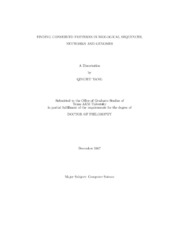| dc.description.abstract | Biological patterns are widely used for identifying biologically interesting regions
within macromolecules, classifying biological objects, predicting functions and studying
evolution. Good pattern finding algorithms will help biologists to formulate and
validate hypotheses in an attempt to obtain important insights into the complex
mechanisms of living things.
In this dissertation, we aim to improve and develop algorithms for five biological
pattern finding problems. For the multiple sequence alignment problem, we propose
an alternative formulation in which a final alignment is obtained by preserving pairwise
alignments specified by edges of a given tree. In contrast with traditional NPhard
formulations, our preserving alignment formulation can be solved in polynomial
time without using a heuristic, while having very good accuracy.
For the path matching problem, we take advantage of the linearity of the query
path to reduce the problem to finding a longest weighted path in a directed acyclic
graph. We can find k paths with top scores in a network from the query path in
polynomial time. As many biological pathways are not linear, our graph matching
approach allows a non-linear graph query to be given. Our graph matching formulation
overcomes the common weakness of previous approaches that there is no
guarantee on the quality of the results.
For the gene cluster finding problem, we investigate a formulation based on constraining the overall size of a cluster and develop statistical significance estimates that
allow direct comparisons of clusters of different sizes. We explore both a restricted
version which requires that orthologous genes are strictly ordered within each cluster,
and the unrestricted problem that allows paralogous genes within a genome and clusters
that may not appear in every genome. We solve the first problem in polynomial
time and develop practical exact algorithms for the second one.
In the gene cluster querying problem, based on a querying strategy, we propose
an efficient approach for investigating clustering of related genes across multiple
genomes for a given gene cluster. By analyzing gene clustering in 400 bacterial
genomes, we show that our algorithm is efficient enough to study gene clusters across
hundreds of genomes. | en |


